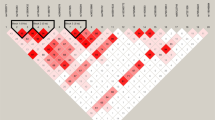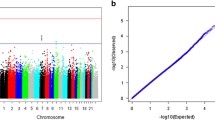Abstract
Epidemiological studies suggest a strong contribution of genetic factors in the pathogenesis of systemic lupus erythematosus (SLE). In the last decades, many risk loci have been identified in several genetic association studies following both candidate gene and genome-wide approaches. The present work was conducted by GAPAID (Genes And Proteins for AutoImmunity Diagnostics) consortium with a dual aim: to replicate the association of several previously reported SLE susceptibility loci in an independent European sample and to explore their relation with some disease subphenotypes. A total of 48 single nucleotide polymorphisms (SNP) from 40 associated loci were typed in a cohort of 208 SLE patients and 152 controls from Rheumatology Units of the University Hospital of Pisa (Italy) and University of Pécs Medical Center (Hungary). Regression analyses were performed to detect disease susceptibility loci and to identify genes affecting specific disease manifestations (renal, neurological, or skin involvement; arthritis; secondary Sjögren syndrome; and secondary antiphospholipid syndrome). Association of previously described risk alleles from HLA locus has been replicated, while IRF5, BLK, ITGAM, and IRF8 loci have been found to be consistent with previous published results. In addition, two new subphenotype-specific associations have been detected: SNP rs5754217 (UBE2L3) with skin involvement and rs3093030 (ICAM1-ICAM4-ICAM5) with hematological disorders. Overall, results from GAPAID project are consistent with previously established associations for HLA, IRF5, BLK, ITGAM, and IRF8 SLE susceptibility loci and report for the first time two subphenotype-specific associations.
Similar content being viewed by others
References
Deapen D, Escalante A, Weinrib L, Horwitz D, Bachman B, Roy-Burman P, Walker A, Mack TM (1992) A revised estimate of twin concordance in SLE. Arthritis Rheum 35:311–8
Alarcón-Segovia D, Alarcón-Riquelme ME, Cardiel MH, Caeiro F, Massardo L, Villa AR, Pons-Estel BA, Grupo Latinoamericano de Estudio del Lupus Eritematoso (GLADEL) (2005) Familial aggregation of systemic lupus erythematosus, rheumatoid arthritis, and other autoimmune diseases in 1,177 lupus patients from the GLADEL cohort. Arthritis Rheum 52:1138–47
Graham RR, Cotsapas C, Davies L et al (2008) Genetic variants near TNFAIP3 on 6q23 are associated with systemic lupus erythematosus (SLE). Nat Genet 40:1059–61
Harley JB, Alarcón-Riquelme ME, Criswell LA et al (2008) Genome-wide association scan in women with systemic lupus erythematosus identifies susceptibility variants in ITGAM, PXK, KIAA1542 and other loci. Nat Genet 40:204–10
Hom G, Graham RR, Modrek B et al (2008) Association of systemic lupus erythematosus with C8orf13-BLK and ITGAM-ITGAX. N Engl J Med 358:900–9
Kozyrev SV, Abelson AK, Wojcik J et al (2008) Functional variants in the B-cell gene BANK1 are associated with systemic lupus erythematosus. Nat Genet 40:211–6
Gateva V, Sandling JK, Hom G et al (2009) A large-scale replication study identifies TNIP1, PRDM1, JAZF1, UHRF1BP1 and IL10 as risk loci for systemic lupus erythematosus. Nat Genet 41:1228–33
Lessard CJ, Adrianto I, Ice JA et al (2012) Identification of IRF8, TMEM39A, and IKZF3-ZPBP2 as susceptibility loci for systemic lupus erythematosus in a large-scale multiracial replication study. Am J Hum Genet 90:648–60
Armstrong DL, Zidovetzki R, Alarcón-Riquelme ME et al (2014) GWAS identifies novel SLE susceptibility genes and explains the association of the HLA region. Genes Immun 15:347–54
Sestak AL, Fürnrohr BG, Harley JB, Merrill JT, Namjou B (2011) The genetics of systemic lupus erythematosus and implications for targeted therapy. Ann Rheum Dis 70(Suppl 1):i37–43
Deng Y, Tsao BP (2010) Genetic susceptibility to systemic lupus erythematosus in the genomic era. Nat Rev Rheumatol 6:683–92
Karassa FB, Trikalinos TA, Ioannidis JP, FcgammaRIIa-SLE Meta-Analysis Investigators (2002) Role of the Fcgamma receptor IIa polymorphism in susceptibility to systemic lupus erythematosus and lupus nephritis: a meta-analysis. Arthritis Rheum 46:1563–71
Karassa FB, Trikalinos TA, Ioannidis JP, FcgammaRIIa-SLE Meta-Analysis Investigators (2003) The Fc gamma RIIIA-F158 allele is a risk factor for the development of lupus nephritis: a meta-analysis. Kidney Int 63:1475–82
Ramos PS, Brown EE, Kimberly RP, Langefeld CD (2010) Genetic factors predisposing to systemic lupus erythematosus and lupus nephritis. Semin Nephrol 30:164–76
Tan EM, Cohen AS, Fries JF, Masi AT, McShane DJ, Rothfield NF, Schaller JG, Talal N, Winchester RJ (1982) The 1982 revised criteria for the classification of systemic lupus erythematosus. Arthritis Rheum 25:1271–7
Willcocks LC, Carr EJ, Niederer HA et al (2010) A defunctioning polymorphism in FCGR2B is associated with protection against malaria but susceptibility to systemic lupus erythematosus. Proc Natl Acad Sci U S A 107:7881–5
Jönsen A, Gunnarsson I, Gullstrand B, Svenungsson E, Bengtsson AA, Nived O, Lundberg IE, Truedsson L, Sturfelt G (2007) Association between SLE nephritis and polymorphic variants of the CRP and FcgammaRIIIa genes. Rheumatology (Oxford) 46:1417–21
Cunninghame-Graham DS, Vyse TJ, Fortin PR et al (2008) Association of LY9 in UK and Canadian SLE families. Genes Immun 9:93–102
Cunninghame Graham DS, Morris DL, Bhangale TR, Criswell LA, Syvänen AC, Rönnblom L, Behrens TW, Graham RR, Vyse TJ (2011) Association of NCF2, IKZF1, IRF8, IFIH1, and TYK2 with systemic lupus erythematosus. PLoS Genet 7, e1002341
Sanchez E, Nadig A, Richardson BC et al (2011) Phenotypic associations of genetic susceptibility loci in systemic lupus erythematosus. Ann Rheum Dis 70:1752–7
Ulker M, Yazisiz V, Sallakci N, Avci AB, Sanlioglu S, Yegin O, Terzioglu E (2009) CTLA-4 gene polymorphism of exon 1(+49 A/G) in Turkish systemic lupus erythematosus patients. Int J Immunogenet 36:245–50
Koldobskaya Y, Ko K, Kumar AA et al (2012) Gene-expression-guided selection of candidate loci and molecular phenotype analyses enhance genetic discovery in systemic lupus erythematosus. Clin Dev Immunol 2012:682018
Prokunina L, Castillejo-López C, Oberg F et al (2002) A regulatory polymorphism in PDCD1 is associated with susceptibility to systemic lupus erythematosus in humans. Nat Genet 32:666–9
Taylor KE, Remmers EF, Lee AT et al (2008) Specificity of the STAT4 genetic association for severe disease manifestations of systemic lupus erythematosus. PLoS Genet 4, e1000084
Sawalha AH, Webb R, Han S et al (2008) Common variants within MECP2 confer risk of systemic lupus erythematosus. PLoS ONE 3, e1727
Musone SL, Taylor KE, Lu TT et al (2008) Multiple polymorphisms in the TNFAIP3 region are independently associated with systemic lupus erythematosus. Nat Genet 40(9):1062–4
Järvinen TM, Hellquist A, Koskenmies S et al (2010) Tyrosine kinase 2 and interferon regulatory factor 5 polymorphisms are associated with discoid and subacute cutaneous lupus erythematosus. Exp Dermatol 19:123–31
Alonso-Perez E, Suarez-Gestal M, Calaza M et al (2012) Further evidence of subphenotype association with systemic lupus erythematosus susceptibility loci: a European cases only study. PLoS ONE 7, e45356
Xu K, Peng H, Zhou M, Wang W, Li R, Zhu KK, Zhang M, Wen PF, Pan HF, Ye DQ (2013) Association study of TRAF1/C5 polymorphism (rs10818488) with susceptibility to rheumatoid arthritis and systemic lupus erythematosus: a meta-analysis. Gene 517:46–54
Sandling JK, Garnier S, Sigurdsson S et al (2011) A candidate gene study of the type I interferon pathway implicates IKBKE and IL8 as risk loci for SLE. Eur J Hum Genet 19(4):479–84
Kim K, Brown EE, Choi CB et al (2012) Variation in the ICAM1-ICAM4-ICAM5 locus is associated with systemic lupus erythematosus susceptibility in multiple ancestries. Ann Rheum Dis 71:1809–14
Sawalha AH, Kaufman KM, Kelly JA et al (2008) Genetic association of interleukin-21 polymorphisms with systemic lupus erythematosus. Ann Rheum Dis 67:458–61
Kaufman KM, Zhao J, Kelly JA et al (2013) Fine mapping of Xq28: both MECP2 and IRAK1 contribute to risk for systemic lupus erythematosus in multiple ancestral groups. Ann Rheum Dis 72:437–44
Purcell S, Neale B, Todd-Brown K et al (2007) PLINK: a tool set for whole-genome association and population-based linkage analyses. Am J Hum Genet 81:559–575
Chung SA, Taylor KE, Graham RR et al (2011) Differential genetic associations for systemic lupus erythematosus based on anti-dsDNA autoantibody production. PLoS Genet 7, e1001323
Rullo OJ, Tsao BP (2013) Recent insights into the genetic basis of systemic lupus erythematosus. Ann Rheum Dis 72(Suppl 2):56–61
Goldberg MA, Arnett FC, Bias WB, Shulman LE (1976) Histocompatibility antigens in systemic lupus erythematosus. Arthritis Rheum 19:129–132
Fernando MM, Freudenberg J, Lee A et al (2012) Transancestral mapping of the MHC region in systemic lupus erythematosus identifies new independent and interacting loci at MSH5, HLA-DPB1 and HLA-G. Ann Rheum Dis 71:777–784
Sanchez E, Comeau ME, Freedman BI et al (2011) Identification of novel genetic susceptibility loci in African American lupus patients in a candidate gene association study. Arthritis Rheum 63:3493–3501
Kunz M, König IR, Schillert A et al (2015) Genome-wide association study identifies new susceptibility loci for cutaneous lupus erythematosus. Exp Dermatol 24(7):510–5
Graham RR, Kyogoku C, Sigurdsson S et al (2007) Three functional variants of IFN regulatory factor 5 (IRF5) define risk and protective haplotypes for human lupus. Proc Natl Acad Sci U S A 104:6758–63
Järvinen TM, Hellquist A, Zucchelli M, Koskenmies S, Panelius J, Hasan T, Julkunen H, D’Amato M, Kere J (2012) Replication of GWAS-identified systemic lupus erythematosus susceptibility genes affirms B-cell receptor pathway signalling and strengthens the role of IRF5 in disease susceptibility in a Northern European population. Rheumatology (Oxford) 51:87–92
Delgado-Vega AM, Dozmorov MG, Quirós MB et al (2012) Fine mapping and conditional analysis identify a new mutation in the autoimmunity susceptibility gene BLK that leads to reduced half-life of the BLK protein. Ann Rheum Dis 71:1219–26
Nath SK, Han S, Kim-Howard X et al (2008) A nonsynonymous functional variant in integrin-alpha(M) (encoded by ITGAM) is associated with systemic lupus erythematosus. Nat Genet 40:152–4
Kim-Howard X, Maiti AK, Anaya JM et al (2010) ITGAM coding variant (rs1143679) influences the risk of renal disease, discoid rash and immunological manifestations in patients with systemic lupus erythematosus with European ancestry. Ann Rheum Dis 69:1329–32
Wang S, Adrianto I, Wiley GB et al (2012) A functional haplotype of UBE2L3 confers risk for systemic lupus erythematosus. Genes Immun 13:380–7
Taylor KE, Chung SA, Graham RR et al (2011) Risk alleles for systemic lupus erythematosus in a large case-control collection and associations with clinical subphenotypes. PLoS Genet 7, e1001311
Agik S, Franek BS, Kumar AA, Kumabe M, Utset TO, Mikolaitis RA, Jolly M, Niewold TB (2012) The autoimmune disease risk allele of UBE2L3 in African American patients with systemic lupus erythematosus: a recessive effect upon subphenotypes. J Rheumatol 39:73-8. J Am Soc Nephrol 25:2859-70.
He CF, Liu YS, Cheng YL et al (2010) TNIP1, SLC15A4, ETS1, RasGRP3 and IKZF1 are associated with clinical features of systemic lupus erythematosus in a Chinese Han population. Lupus 19:1181–6
Qin L, Lv J, Zhou X, Hou P, Yang H, Zhang H (2010) Association of IRF5 gene polymorphisms and lupus nephritis in a Chinese population. Nephrology (Carlton) 15:710–3
Li SW, He Y, Zheng ZH, Liu DW, Liu ZS (2014) Single-nucleotide polymorphisms of IRF8 gene are associated with systemic lupus erythematosus in Chinese Han population. Int J Immunogenet 41:112–8
Yu B, Chen Y, Wu Q et al (2011) The association between single-nucleotide polymorphisms of NCF2 and systemic lupus erythematosus in Chinese mainland population. Clin Rheumatol 30:521–7
Acknowledgments
The authors thank for the technical and human support provided by Sequencing and Genotyping Facilities from SGIker of UPV/EHU. This work was supported by the European Union Seventh Framework Programme FP7/2007-2013 (grant agreement n° 314971).
Author information
Authors and Affiliations
Corresponding author
Ethics declarations
Ethic statement
This study was approved by the Ethics Committee of the University Hospital of Pisa (reference number: 45066/2012) and the Hungarian Scientific and Research Ethics Board (reference number: 24973-1/2012 EKU). The procedures followed were in accordance with the Helsinki Declaration of 1975. All the patients gave written informed consent.
Disclosures
None.
Rights and permissions
About this article
Cite this article
Ruiz-Larrañaga, O., Migliorini, P., Uribarri, M. et al. Genetic association study of systemic lupus erythematosus and disease subphenotypes in European populations. Clin Rheumatol 35, 1161–1168 (2016). https://doi.org/10.1007/s10067-016-3235-8
Received:
Revised:
Accepted:
Published:
Issue Date:
DOI: https://doi.org/10.1007/s10067-016-3235-8




